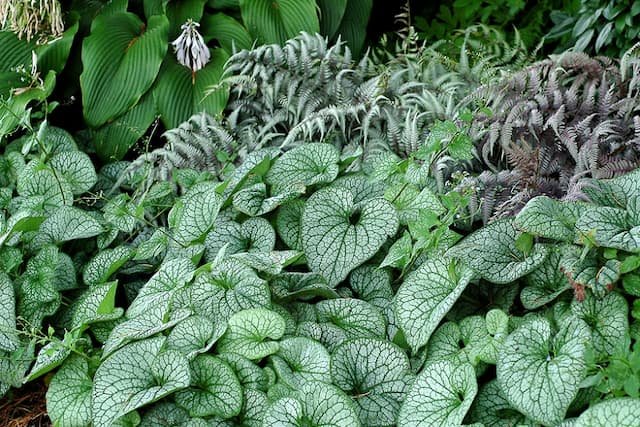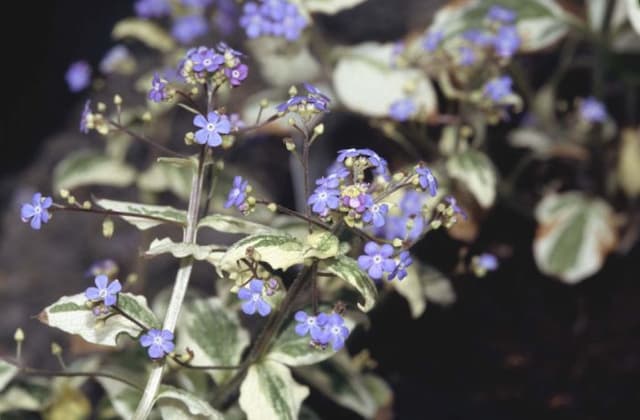Variegated Comfrey Symphytum × uplandicum 'Variegatum' (v)

ABOUT
Variegated comfrey is an eye-catching plant due to its distinctive foliage and flowers. The leaves of variegated comfrey are broad and textured, with a unique variegation pattern characterized by creamy white edges that contrast strikingly with the dark green center. The variegation adds a splash of light to shady garden areas, making it a popular choice for ornamental purposes. The flowers are bell-shaped and dangle gracefully in clusters. They are typically purple, pink, or cream in color, which adds to the decorative appearance of the plant. These flowers usually bloom in the spring or early summer, providing a soft, subtle color that can complement other garden blooms. Variegated comfrey has a bushy habit, with the leaves growing densely to create a lush appearance. The overall look of the plant is one of robust vitality, with a mix of colors and textures that make it stand out in garden beds or borders. Although this plant has a strong presence due to its foliage and flowering characteristics, it's generally appreciated for its ornamental value and unique aesthetic contributions to the garden landscape.
About this plant
 Names
NamesFamily
Boraginaceae.
Synonyms
Variegated Russian Comfrey, Ornamental Comfrey, Variegated Comfrey.
Common names
Symphytum peregrinum, Symphytum asperum × Symphytum officinale
 Toxicity
ToxicityTo humans
Comfrey, the common name for Symphytum × uplandicum 'Variegatum', contains pyrrolizidine alkaloids, which are known to be hepatotoxic to humans. If ingested in large quantities, these alkaloids can cause liver damage, manifesting as hepatic veno-occlusive disease. Symptoms of poisoning may include abdominal pain, nausea, vomiting, and in severe cases, liver failure. Chronic exposure can also increase the risk of liver cancer. It is important to note that simply touching the plant is not harmful; the risk arises from ingestion of the leaves or roots.
To pets
Comfrey, the common name for Symphytum × uplandicum 'Variegatum', is also toxic to pets due to the presence of pyrrolizidine alkaloids. These compounds can lead to liver damage in animals if ingested. Symptoms of comfrey poisoning in pets may include vomiting, diarrhea, lethargy, jaundice, or changes in liver function. In severe cases, ingestion may result in liver failure. As with humans, the primary risk is associated with ingestion rather than contact. Pet owners should prevent their animals from consuming any part of the plant.
 Characteristics
CharacteristicsLife cycle
Perennials
Foliage type
Deciduous
Color of leaves
Variegated
Flower color
Mixed
Height
2-3 feet (60-90 cm)
Spread
2-3 feet (60-90 cm)
Plant type
Herb
Hardiness zones
4-8
Native area
Europe
Benefits
 General Benefits
General Benefits- Aesthetic Appeal: Symphytum × uplandicum 'Variegatum,' commonly known as variegated comfrey, adds visual interest to gardens with its variegated foliage, featuring green leaves edged with creamy white margins.
- Attracts Wildlife: Variegated comfrey is known to attract beneficial insects, including pollinators such as bees, which can help pollinate other plants in the garden.
- Soil Improvement: As a dynamic accumulator, this plant has deep roots that mine the soil for nutrients, potentially improving soil fertility when the leaves decompose.
- Low Maintenance: Once established, variegated comfrey is a low-maintenance plant that requires minimal care, making it suitable for gardeners of all skill levels.
- Drought Tolerance: This plant is relatively drought-tolerant, which can be particularly useful in areas with water restrictions or for creating a low-water garden.
- Ground Cover: Due to its dense growth habit, variegated comfrey can act as an effective ground cover, suppressing weeds and reducing garden maintenance.
- Companion Planting: It can be used in companion planting to provide ground cover and bring in beneficial insects, supporting the health and productivity of surrounding plants.
 Medical Properties
Medical Properties- Wound healing: Symphytum × uplandicum 'Variegatum', commonly known as variegated comfrey, has been traditionally used in topical applications to promote the healing of cuts, bruises, and broken bones.
- Anti-inflammatory: Compounds within variegated comfrey may provide anti-inflammatory benefits, potentially aiding in the reduction of swelling and pain in conditions such as sprains and arthritis.
- Pain relief: The plant is sometimes used in the form of poultices or creams for its analgesic properties, to alleviate pain in aching joints and muscles.
- Skin regeneration: Variegated comfrey contains allantoin, a compound known to speed up the natural replacement of body cells, which can be beneficial in skin care and regeneration.
 Air-purifying Qualities
Air-purifying QualitiesThis plant is not specifically known for air purifying qualities.
 Other Uses
Other Uses- Comfrey, the most common name for Symphytum × uplandicum 'Variegatum', is often used as a compost activator due to its high nitrogen content, which helps to accelerate the decomposition process.
- The plant can be used in liquid fertilizers or "comfrey tea," providing a nutrient-rich solution favored by organic gardeners to promote the growth of vegetables and fruits.
- Comfrey is known to attract beneficial insects like honeybees and bumblebees, making it a valuable addition to a pollinator-friendly garden.
- The deep root system of comfrey is effective in breaking up compacted soils, thereby improving soil structure and facilitating drainage.
- Comfrey leaves are sometimes used as a natural mulch, as they suppress weeds and gradually release nutrients into the soil as they decompose.
- The roots and foliage of comfrey can be used as a feedstock in biogas production systems, due to their rapid growth rate and high biomass yield.
- Dried comfrey leaves are used by some to create a green dye for textiles, although this is a less common practice.
- Plant fibers extracted from comfrey stems have been explored as an alternative material for making paper or cardboard.
- Due to its texture and non-toxicity, comfrey leaves have been used as a natural cleaning scrub for garden tools without the risk of corrosion.
- The plant can function as a living barrier or low hedge in gardens due to its dense foliage and quick growth, providing a degree of privacy and wind protection.
Interesting Facts
 Feng Shui
Feng ShuiThe comfrey is not used in Feng Shui practice.
 Zodiac Sign Compitability
Zodiac Sign CompitabilityThe comfrey is not used in astrology practice.
 Plant Symbolism
Plant Symbolism- Healing and Recovery: Symphytum × uplandicum 'Variegatum', commonly known as variegated comfrey, has been traditionally used for its medicinal properties. It symbolizes healing because of its ability to aid in wound repair and reduce inflammation.
- Protection: Comfrey has also been associated with protection due to its sturdy nature. Gardeners might plant it to symbolize a desire to safeguard their garden and promote healthy growth of other plants nearby.
- Resilience and Adaptability: The ability of variegated comfrey to thrive in various soil conditions makes it symbolize resilience and adaptability, reminding us to persevere through challenges and adjust to new environments.
 Water
WaterVariegated comfrey should be watered deeply, ensuring the water reaches the roots, about once a week during the growing season. During hot, dry spells, it may require water twice a week. Use about 1 to 1.5 gallons per plant for each watering session. During the winter, reduce watering frequency to once every two to three weeks, depending on the soil moisture. It's important not to overwater, as this can lead to root rot.
 Light
LightVariegated comfrey thrives best in full to partial sunlight. It should be placed in a spot where it can receive at least 4-6 hours of direct sun daily, but it can also tolerate some shade, which can be beneficial in areas with very hot summers.
 Temperature
TemperatureVariegated comfrey is hardy and can tolerate temperatures as low as 50 degrees Fahrenheit and as high as 85 degrees Fahrenheit without issue. However, it grows best in temperatures ranging from 55 to 75 degrees Fahrenheit. It should be protected from extreme cold and frost.
 Pruning
PruningPrune variegated comfrey to remove any dead or damaged leaves and to control its size. It's best to prune in early spring before new growth begins. Pruning can be done again in late fall if necessary to tidy the plant. Pruning also stimulates new growth and keeps the plant looking its best.
 Cleaning
CleaningAs needed
 Soil
SoilVariegated comfrey prefers a rich, well-draining soil with a neutral to slightly acidic pH of 6.0 to 7.0. The best soil mix would include garden loam, peat moss, and perlite or sand to ensure good drainage while retaining adequate moisture.
 Repotting
RepottingVariegated comfrey typically does not need frequent repotting as it is a robust plant. It should be repotted every 2 to 3 years to refresh the soil and accommodate the root growth.
 Humidity & Misting
Humidity & MistingVariegated comfrey is adaptable to a range of humidity levels but thrives best in average room humidity, around 40-60%. It does not require special humidity conditions.
 Suitable locations
Suitable locationsIndoor
Place in bright, indirect light and water routinely.
Outdoor
Plant in partial shade, keep soil moist and well-drained.
Hardiness zone
4-9 USDA
 Life cycle
Life cycleSymphytum × uplandicum 'Variegatum', commonly known as Variegated Comfrey, begins its life cycle when seeds are sown in the ground or when root cuttings are planted. Germination unfolds in warm, moist soil, whereupon seedlings emerge and establish a deep taproot alongside robust, hairy leaves. As the plant matures, it forms a clumping habit with variegated leaves that exhibit a unique pattern of cream and green. In late spring to early summer, bell-shaped flowers ranging in color from creamy-yellow to purple appear, attracting pollinators to the garden. After flowering, the plant sets seed which can self-sow, perpetuating its life cycle, while the parent plant can also propagate vegetatively via its root system. During winter, the foliage dies back to the ground, with the perennial rootstock overwintering to send up new growth the following spring.
 Propogation
PropogationPropogation time
Spring-Early Summer
The most popular method of propagation for Symphytum × uplandicum 'Variegatum', commonly known as variegated comfrey, is division. This is typically done in the spring when the plants are emerging and the soil is workable. To propagate by division, carefully dig up an established clump of variegated comfrey and gently separate the roots into smaller sections, making sure each section has a portion of the root system and a few growing points or shoots. These divisions can then be immediately replanted in well-prepared soil, spaced about 12 to 24 inches (30 to 60 cm) apart to allow room for growth. Water the newly planted divisions thoroughly to help establish them. This method generally yields new plants that are ready to grow vigorously and flower in the same season, perpetuating the ornamental and herbal qualities of variegated comfrey in the garden.









